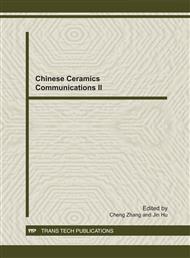p.410
p.415
p.422
p.427
p.432
p.436
p.441
p.445
p.449
CASTEP Calculation of Surface Property of Mullite Composites and Analysis of Crystal Growth Habit
Abstract:
According to the conditions of preparation of mullite composites by open-system hydrothermal crystallization method, surface energies of mullite crystal were calculated by the first principle plane pseudo-potential. Growth habit plane of mullite composites was also discussed and analyzed. The calculation results demonstrate that surface energies of (001), (010), (100), (210) and (120) of mullite crystal are 0.337KeV•nm-2, 0.029KeV•nm-2, 0.027KeV•nm-2, 0.032KeV•nm-2, 0.037KeV•nm-2, respectively. That is to say, the surface energies of mullite crystal follow the order of (001) >> (210) > (120) > (100) > (010). It is also found that E(001) is much larger than others. According to Curie-Wulff principle, growth rate of crystal face is directly proportional to its surface energy, which shows that growth rate of mullite crystal in (001) direction is the fastest and mullite crystal is favorable for one-dimensional growth to columnar.
Info:
Periodical:
Pages:
432-435
Citation:
Online since:
November 2011
Authors:
Keywords:
Price:
Сopyright:
© 2012 Trans Tech Publications Ltd. All Rights Reserved
Share:
Citation:


